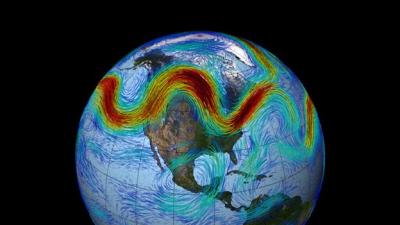Rain and Cloud in the Midlatitude Storm Track Provide Important Source of Persistence in the Southern Annular Mode
Jet streams travel around the Earth and move north and south on cycles that last over two months, which is beyond the usual range of weather forecasts. Understanding the source of this “memory” directly affects our ability to predict the jet steam’s response to climate change. Most of the theories for understanding the jets’ behavior are dry dynamics-centric (i.e. without considering the role of water in the atmosphere) and have ignored the effect of water vapor and clouds. This study shows that dry dynamics alone is not enough to understand jet stream persistence. Instead, clouds and precipitation are more important contributors than internal “dry” mechanisms to this memory of the Southern Hemisphere jet. Researchers also find that the heating and cooling due to the pattern in the precipitation hinders the poleward migration of the jet stream.
The moist processes involved in precipitation, especially clouds, are a major source of model bias and model uncertainty. Moist feedback playing a leading role in the persistence of the Southern Annular Mode (SAM) implies a diabatic source for the uncertainty in the jet shifts projected by generations of climate models and leads to an inability to accurately predict these shifts. Future improvement in the representation of these moist processes may help narrow the inter-model spread in the projected changes of the westerly jet.
As a dominant mode of jet variability on subseasonal time scales, the SAM provides a window into how the atmosphere can produce internal oscillations on longer-than-synoptic time scales, which last about 7 – 10 days. The time scale for the persistence and propagation of the SAM is set by complex interplay of both dry and moist processes in the storm track, making the exact physical mechanisms challenging to identify and to simulate, even in latest generation models. Moist processes, including condensation and radiative heating, are the main contributors to SAM’s persistence in its stationary regime, while acting as a hinderance to the SAM’s propagation regime. The analysis further reveals that propagation is initiated by barotropic shifts in upper-level wave breaking and then sustained by a baroclinic response, leading to a roughly 60-day oscillation period. This barotropic propagation mechanism has been identified in dry, idealized models. However, this research shows evidence of this mechanism for the first time in reanalysis. Given the lead-order importance of the moist processes in the storm track, future attempts to improve the SAM time scale in models should focus on the storm-track location, as well as the roles of the cloud and moisture parameterizations.

